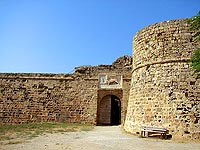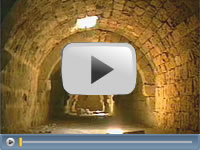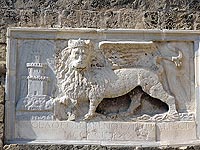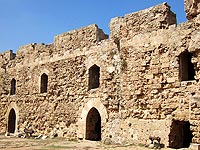
The Othello Tower and Castle in Famagusta, North Cyprus.
 |
the north cyprus travel guide |
 |
|
Othello Tower and Castle
The most famous part of the walls surrounding the city of Famagusta has to be the Citadel, commonly referred to as Othello's Castle. In the Shakespeare play, Othello the Moor was a Venetian commander, sent by his masters to Cyprus, where "The fortitude of the place is well known to you." From Act II onwards, the play is simply set in 'A seaport in Cyprus' and also in 'A hall in the castle'. Shakespeare in North Cyprus?Of course, Shakespeare never visited Cyprus, but he may have heard the story of Sir Cristoforo Moro, a governor of Cyprus in the early 1500s, whose young wife died on the sea journey back from Cyprus. Sir Cristofor was not a Moor, but his surname may have suggested the change of race to Shakespeare for his lead character, that gives his play such inner tension. The Real Othello in Northern Cyprus?
Alternatively, the character of Othello may have been based on Francesca de Sessa, a Venetian officer serving in Cyprus. He was known as "Il Moro" because of his dark skin, and was punished by exile in 1544 for a unknown offence. Whatever the inspiration, the power of Shakespeare's play of a marriage torn apart by jealousy and the evil plotting of Othello's friend Iago, bring visitors flocking to this impressive building. Othello's Tower is not so much as tower as a castle in its own right, within the fortress walls of the city of Famagusta. This Citadel was originally built by the Lusignans to defend both town and harbour, and today it dominates the modern-day port as it has for hundreds of years. The harbour could be closed by a chain, one end of which was hung from the chain tower just opposite the Citadel. The pile of stones on the promontory you can see today mark the original position of this chain tower. The Citadel and Sea Gate of Famagusta, Northern Cyprus
The Citadel also guards the Sea Gate, one of only two original gates in the walls, built by the Venetians in 1496. Before the events of 1974, cruise ships would stop at the port of Famagusta, and the first sight greeting visitors was the impressive Citadel or Othello's Tower. Nowadays such a spectacular view is reserved for the container ships in the modern day port. You can no longer enter Famagusta via the Sea Gate; the tower entrance is from inside the walls, through a gate with a Venetian stone lion of St Mark carved into the stone above it. Look closely and you'll also find the name of the Venetian architect who remodelled the Citadel in 1492, Nicolo Foscarini. The original Citadel moat was drained of water by the British in 1900, to combat the risk of malaria. Inside Othello's Tower, Famagusta, North CyprusOnce inside the tower, you really begin to appreciate its scale. Cannons still occupy the open courtyard, along with piles of iron cannon balls, and one Spanish bronze cannon has resisted the elements to retain its fine condition. The Turkish cannons can be recognised by the brass rings around the barrel, designed to prevent injury if the cannon itself should explode. The much larger stone balls you may see were more likely to have been flung using a trebuchet, or siege catapult. Often a stage is set in this courtyard for folk dancing performances. The Great Hall of Othello's Tower. Famagusta
Around the courtyard are large rooms, the most magnificent of which is the Great Hall or Refectory. At a massive 28 metres long, many believe it is this hall that Shakespeare refers to in his stage instruction quoted above. At one end is a large kitchen, and the whole hall seems somewhat dark, due to the lack of windows. Windows, of course, were unglazed and kept small so no cannon fire could get through! However, the fine limestone vaulting of the ceiling is being gradually eroded eaten away by the salty sea air. The Hidden Treasure of Othello's Tower, FamagustaFrom the northeast tower you can catch a glimpse of the industrial port below, and the ventilation shafts that drop down to Lusignan passages below. The Venetians filled many of these shafts to prevent cannon balls penetrating them, but rumours still persist that these lost chambers may contain hidden treasures, left behind by the Venetians when they surrendered to the Ottomans. Several excavations have been made over the years, but no treasure has been found – yet! |
|
North Cyprus quick: holidays | flights | hotels | property | kyrenia | famagusta | photos | map | weather | history | news
All text is copyrighted by Cyprus44. Photographs are copyrighted by their respective photographers.
For more information read our copyright policy, privacy policy and disclaimer.
This web page is served on 18 September 2025 at 1:34:49 AM.
![]()
Cyprus44 in other languages: Nordzypern | Chypre Nord | Severní Kypr | Северный Кипр
partner sites: goNorthCyprus Travel | Pacific Rent-A-Car | Amy Holiday Villas | other partner sites











